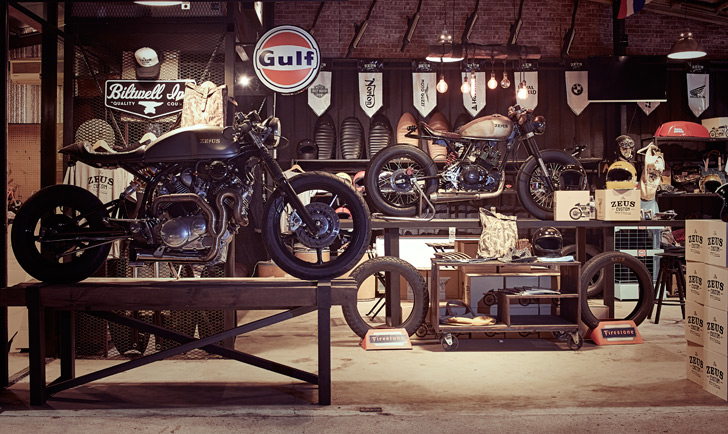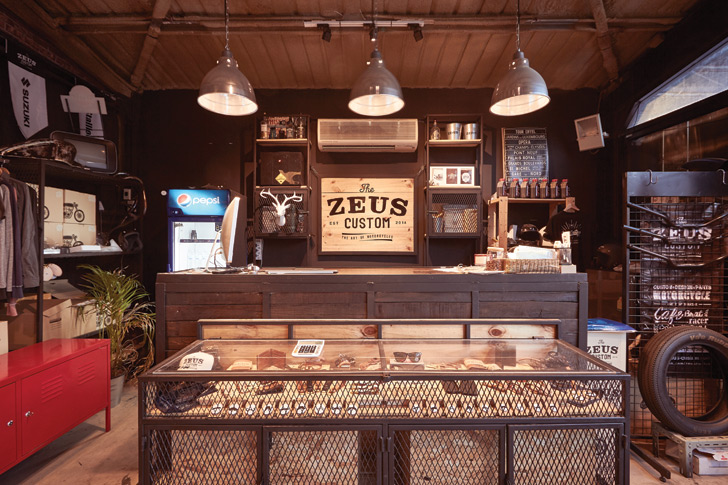No one else rides a motorcycle like Mooyong’s. That’s no mere bravado; it’s a simple fact that his stripped-down, café-racer Royal Enfield 535 is a one-of-a-kind specimen that he has spent the best part of three years customising.
Mooyong – whose real name is Worawit Reuangjantanukun, but prefers the nickname – is the owner and founder of Zeus Custom, a Bangkok-based custom motorcycle shop that looks as though it was designed by a steampunk architect and a handful of hipsters.
“All of our bikes are unique, because I like creating something new,” says Mooyong, whose motorcycle aesthetics transcend the machines, demonstrated by his brown desert boots, tight denim jeans and casual plain t-shirt. “People bring in their bikes and say: ‘I’ve seen a bike you’ve customised; I want mine to look the same.’ And then I tell them: ‘I’ll make you a unique bike; no copy.’”
“Some people have a style they love, and I believe everyone should have what they love.”
Mooyong
Mooyong says that two years ago, everyone in Thailand wanted the same, mass-produced motorcycle. Now – after customising more than 800 bikes – he sees desires changing. People are craving unique, personalised motorcycles, not just the same models. “I love classic, unique bikes,” he says. “And some people have a style they love, and I believe everyone should have what they love.”
Clearly, understanding the fundamentals of ‘why’ people are turning away from mass-produced products to customised ones does not trouble Mooyong. He is an empiricist, not a theoretician, and all is good for him as long as he continues doing what he loves and people continue using his shop.
Acacia Leroy, on the other hand, has to know why. As the trend strategist for Asia-Pacific at TrendWatching – an independent consumer trends analysis firm whose client list includes Unilever, McDonalds and Google – it is her job to uncover emerging business innovations and analyse why consumers are buying them. One of the global ‘megatrends’ her organisation is currently tracking is encapsulated in Mooyong’s business. They have dubbed it “Youniverse”.
Move to customisation
“It is about how consumers are moving away from mass consumption to mass customisation,” she explains. “This megatrend arises from people’s basic needs of self-expression and social recognition for their individual tastes, personality and identity through consumption.”
When the consumer society first burgeoned in the US at the turn of the 20th century, one man personified its rise: Henry Ford. As the founder of the Ford Motor Company, he popularised assembly line production, allowing for the mass production of identical, inexpensive goods, which in turn allowed hundreds of thousands of people to join the ranks of the consumer class.
Ford’s disregard for individual choice was summed up in his famous quip: “Any customer can have a car painted any colour that he wants, so long as it is black.” He even leant his name to this new economic system: Fordism.
Today, the US and much of Europe is said to be in a post-Fordism phase. Mass production has declined, and consumer habits have shifted. People no longer aspire to own the same product as everyone else. Instead, they want bespoke, individualised goods. They are niche consumerists.

In the 1997 book Commodify Your Dissent, journalists Thomas Frank and Matt Weiland traced the US transition from mass to niche consumerism to the countercultural ethos of the 1950s and 1960s. They wrote that the patron saints of American counterculture were the Beat writers – led by the triumvirate of Jack Kerouac, Allen Ginsberg and William S. Burroughs – who “transformed the American imagination” with their promotion of immediate gratification, rejection of moral restraint and complete aversion to anything that was seen as mainstream.
Consumerism in 1950s America was very much about ‘keeping up with the Joneses’ and aspiring to own the same products as everyone else. However, within a decade of the counterculture boom, big business had appropriated its mores and, by the 1970s, consumerism in the US was “no longer about ‘conformity’ but about ‘difference’,” Frank and Weiland wrote. “This imperative of endless difference is today the genius at the heart of American capitalism.”
Across the Pacific, Leroy believes that a similar shift is now happening in Southeast Asia. And she thinks she knows why: up until a few years ago, she argues, people in Asia valued community more than anything, which encouraged “individuals to blend in and be ‘part of the crowd’”. This is now changing. “More and more people value individuality and self-expression, and it is now [everything], from school education and self-development classes to advertising campaigns, that tells people to ‘be yourself’,” she says.
She puts this change down to the growing influence of Western culture, globalisation, more freedom of expression – especially on the internet, “where everyone can have a voice and be heard” – and the sort of lifestyle that urbanisation has created for Southeast Asia’s estimated 132 million city slickers.
“Of course, when people do not have any money to even eat, they would not really care about customising their consumption,” she adds. “But niche consumption doesn’t have to be expensive. Securing the best deals on one-of-a-kind pieces at vintage shops is a status symbol for consumers nowadays, and the main promoter of this consumer trend is not just economic.”
A good indication of this shift can be observed in the advertising campaigns of brands in the region. In August, for example, Carlsberg Malaysia launched a digital campaign on Facebook that tailored their advertisements to the user’s age and music tastes. Another feature allowed Facebook users to insert their own name instead of the ‘Carl’ of Carlsberg, in a similar move to Coca-Cola’s global campaign of including different names on cans to personalise the experience of imbibing the fizzy drink.
“Now brands are recognising that consumers love the bespoke, and they are tailoring each consumer experience to suit the individual tastes and preferences,” Leroy says.

However, while Leroy evokes niche consumerism as attainable for many, not everyone is convinced that bespoke products have the same reverence for most in Southeast Asia.
Thomaï Serdari is an adjunct professor of marketing at the Leonard N. Stern School of Business in New York City and the editor of the journal, Luxury: History, Culture, Consumption.
She says that consumer behaviour and the desire for niche products come down to three factors: the person’s level of education, their experience in the luxury market and their overall sophistication.
“The more a person participates in companies’ marketing initiatives – from promotional initiatives to educational seminars to actual product purchases – the more sophisticated she becomes,” Serdari says. “This allows her to move away from mass appeal products, big logos and, generally speaking, away from claiming her spot in the social group via possession of specific ‘it’ products.”
As someone becomes more sophisticated, she reasons, they become more attentive to the craftsmanship and aesthetics of a product. When this happens, they begin purchasing products that are subtler, less common and more individual. Essentially: products that differentiate them from the crowd.
However, this process takes time, Serdari says. The upper classes of Southeast Asia have had the financial means to begin this process, long before the nouveau middle-classes, so their desire for bespoke products is more acute. Furthermore, Serdari posits that the difference between ‘becoming part of the crowd’ and ‘standing out’ through consumerism is not black and white. Instead, mass and niche consumption are “two extremes on an axis made of an infinite number of points”.
In simpler terms, consumers might gravitate towards mass or niche consumerism, but they might also exhibit different behaviour in different product categories. For example, someone with knowledge of luxury bags might choose to ‘stand out’ by purchasing one that few people recognise. However, the same person might have no idea about champagne and end up buying a bottle just because it has a recognisable label.
“Unless we are discussing true aesthetes who are motivated to consume a product category because they really appreciate a particular taste, colour, texture, et cetera,” Serdari continues, “then everyone is seeking personal satisfaction both through the beauty of the product and through the knowledge of having the money to purchase it.”
Serdari concludes that niche products and brands are certainly the way of the future. Leroy’s “Youniverse” megatrend would also suggest the same. And Mooyong would hope for this to be true – at least for motorcycles.


